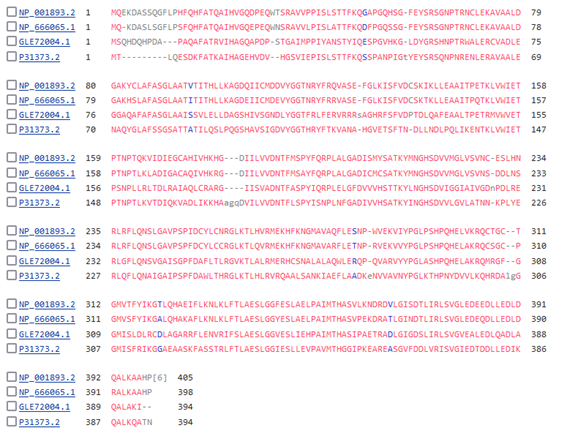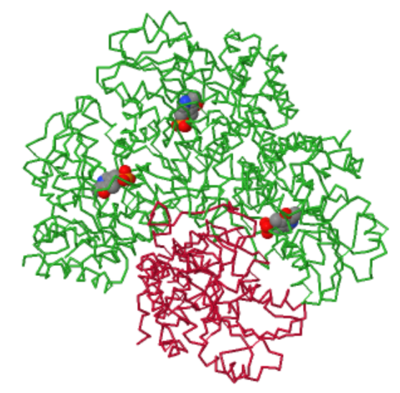User:João Pedro de Carvalho Pereira/Sandbox 1
From Proteopedia
(Difference between revisions)
| Line 30: | Line 30: | ||
Another noteworthy observation is that two variants of the CSE protein, associated with cystathionuria, are distinguished by a diminished enzymatic activity owing to a deficiency in PLP binding to CSE. Interestingly, the mutated amino acids in these variants do not encompass the aforementioned residues that engage in direct interaction with the cofactor, thus underscoring the uncertainties and the imperative for additional investigations concerning cystathionine gamma-lyase.<br> | Another noteworthy observation is that two variants of the CSE protein, associated with cystathionuria, are distinguished by a diminished enzymatic activity owing to a deficiency in PLP binding to CSE. Interestingly, the mutated amino acids in these variants do not encompass the aforementioned residues that engage in direct interaction with the cofactor, thus underscoring the uncertainties and the imperative for additional investigations concerning cystathionine gamma-lyase.<br> | ||
<br> | <br> | ||
| - | During its enzymatic function, the PLP-bound CSE protein interacts with L-cysteine, leading to the dissociation of PLP from the protein and its subsequent interaction with L-cysteine, resulting in the formation of PLP-iminopropionate and the release of H<sub>2</sub>S. This interaction is facilitated by the deprotonation of the substrate, catalyzed by the <scene name='97/973103/Arg62/1'>amino acid Arg<sup>62</sup></scene> from an adjacent monomer<ref name="x"/>, specifically one of the neighboring subunits within the tetramer. This underscores the critical role of the quaternary structure in enzymatic activity of this protein. Another noteworthy aspect of the binding of L-cysteine to CSE pertains to the amino acid | + | During its enzymatic function, the PLP-bound CSE protein interacts with L-cysteine, leading to the dissociation of PLP from the protein and its subsequent interaction with L-cysteine, resulting in the formation of PLP-iminopropionate and the release of H<sub>2</sub>S. This interaction is facilitated by the deprotonation of the substrate, catalyzed by the <scene name='97/973103/Arg62/1'>amino acid Arg<sup>62</sup></scene> from an adjacent monomer<ref name="x"/>, specifically one of the neighboring subunits within the tetramer. This underscores the critical role of the quaternary structure in enzymatic activity of this protein. Another noteworthy aspect of the binding of L-cysteine to CSE pertains to the amino acid Tyr<sup>114</sup>, which undergoes significant perturbation upon the binding of PLP to the protein. It is hypothesized that this particular amino acid plays a pivotal role in the subsequent release of the substrate following the enzymatic reactions involving the binding of L-cysteine to PLP<ref name="x"/>. |
Revision as of 03:45, 26 June 2023
Cystathionine gamma-lyase (Homo sapiens)
| |||||||||||
References
- ↑ 1.0 1.1 Chiku T, Padovani D, Zhu W, Singh S, Vitvitsky V, Banerjee R. H2S biogenesis by human cystathionine gamma-lyase leads to the novel sulfur metabolites lanthionine and homolanthionine and is responsive to the grade of hyperhomocysteinemia. J Biol Chem. 2009 Apr 24;284(17):11601-12. doi: 10.1074/jbc.M808026200. Epub 2009, Mar 4. PMID:19261609 doi:10.1074/jbc.M808026200
- ↑ Messerschmidt A, Worbs M, Steegborn C, Wahl MC, Huber R, Laber B, Clausen T. Determinants of enzymatic specificity in the Cys-Met-metabolism PLP-dependent enzymes family: crystal structure of cystathionine gamma-lyase from yeast and intrafamiliar structure comparison. Biol Chem. 2003 Mar;384(3):373-86. PMID:12715888
- ↑ 3.0 3.1 3.2 3.3 3.4 3.5 3.6 3.7 Sun Q, Collins R, Huang S, Holmberg-Schiavone L, Anand GS, Tan CH, van-den-Berg S, Deng LW, Moore PK, Karlberg T, Sivaraman J. Structural basis for the inhibition mechanism of human cystathionine gamma-lyase, an enzyme responsible for the production of H(2)S. J Biol Chem. 2009 Jan 30;284(5):3076-85. Epub 2008 Nov 19. PMID:19019829 doi:http://dx.doi.org/10.1074/jbc.M805459200
- ↑ 4.0 4.1 Adaikan PG, Karim SM. Effects of PGA and PGB compounds on gastrointestinal tract smooth muscle from man and laboratory animals. Prostaglandins. 1976 Jan;11(1):15-22. PMID:1257494 doi:10.1016/0090-6980(76)90168-4
- ↑ Scott CR, Dassell SW, Clark SH, Chiang-Teng C, Swedberg KR. Cystathioninemia: a benign genetic condition. J Pediatr. 1970 Apr;76(4):571-7. PMID:5420794 doi:10.1016/s0022-3476(70)80407-3
- ↑ Wang J, Hegele RA. Genomic basis of cystathioninuria (MIM 219500) revealed by multiple mutations in cystathionine gamma-lyase (CTH). Hum Genet. 2003 Apr;112(4):404-8. Epub 2003 Feb 6. PMID:12574942 doi:10.1007/s00439-003-0906-8


